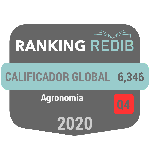Efeito da irradiância solar, do tipo de substrato e do ambiente no crescimento e qualidade ornamental de plantas de Euphorbia cotinifolia
Resumo
A Euphorbia cotinifolia L. é uma planta ornamental de importância econômica devido à cor vermelho-púrpura de sua folhagem. Foi avaliado o efeito da radiação solar, do tipo de substrato e do ambiente no crescimento e qualidade ornamental de plantas de E. cotinifolia, propagadas a partir de estacas semi-lenhosas. Dois experimentos foram conduzidos de junho de 2022 a março de 2023, em Tetela de Ocampo e Huitzilan de Serdán, Puebla, México. Cada experimento tinha 20 tratamentos. Os experimentos tinham um projeto fatorial 2x5x2; o fator 1 era ambientes de crescimento, seus níveis: clima temperado (STC) e subtropical (SHC). O fator 2 foi a irradiância solar, seus níveis: 80, 240, 347, 394 e 571 µmol.m-2.s-1. O fator 3 foi o tipo de substrato, seus níveis: areia de rio com turfa (AT) e solo de floresta com perlita (SP). Aos 243 dias após o enraizamento, os valores mais altos foram: 32,98 cm para o crescimento do broto terminal, 4,80 mm.dia-1 na taxa de crescimento, 1,76 no índice de robustez, 1,32 no índice de Dickson. A concentração máxima de antocianina foi de 4,94 mg.g-1 nas folhas vermelho-púrpura. Os valores mais altos e a cor vermelho-púrpura da folhagem (indicador de qualidade) ocorreram quando as plantas foram cultivadas em substrato AT, a 571 µmol.m-2.s-1 no clima SHC. Conclui-se que num clima subtropical, as plantas se desenvolvem com melhor qualidade; recomenda-se como substrato areia de rio com turfa e exposição a altas intensidades de luz.
Downloads
Referências
Chandler, S., & Brugliera, F. (2011). Genetic modification in floriculture. Biotechnology Letters, 33(2), 207–214. https://doi.org/10.1007/s10529-010-0424-4
Charcape, J. M., Correa, V. A., & Chunga, J. C. (2015). Especies arbóreas presentes en la Región Piura. INDES Revista de Investigación para el Desarrollo Sustentable, 3(1), 60–85. https://doi.org/10.25127/indes.20153.135
de Oliveira, J. H., & Sartori-Paoli, A. A. (2016). Morfologia e desenvolvimento da plântula de Acalypha gracilis (Spreng.) Müll. Arg., Euphorbia cotinifolia L. e Jatropha gossypiifolia L. (Euphorbiaceae). Arnaldoa, 23 (2), 443 – 460. http://doi.org/10.22497/arnaldoa.232.23204
Desrosiers, S. L., Collin, A., & Bélanger, N. (2024). Factors affecting early red oak (Quercus rubra L.) regeneration near its northern distribution limit in Quebec. Frontiers in Forest and Global Change, 7, 1451161. https://doi.org/10.3389/ffgc.2024.1451161
Dos Santos, F. K. F., Dos Santos, E. O. V., Veiga-Junior, V. F., & Teixeira-Costa, B. E. (2024). Hibiscus rosa-sinensis. (A. K. Gupta, V. Kumar, B. Naik, & P. Mishra, Eds.; Academic Press, pp. 127–156). Edible Flowers. https://doi.org/10.1016/B978-0-443-13769-3.00008-X
El Mokni, R. (2023). Non-native shrubby species of Euphorbia (Euphorbiaceae) in Tunisia. Flora Mediterranea, 33, 17–29. https://doi.org/10.7320/FlMedit33.017
Enaru, B., Dretcanu, G., Pop, T. D., Stanila, A., & Diaconeasa, Z. (2021). Anthocyanins: factors affecting their stability and degradation. Antioxidants, 10, 1967. https://doi.org/10.3390/antiox10121967
Frajman, B., & Geltman, D. (2021). Evolutionary origin and systematic position of Euphorbia normannii (Euphorbiaceae), an intersectional hybrid and local endemic of the Stavropol Heights (Northern Caucasus, Russia). Plant Systematics and Evolution, 307, 20. https://doi.org/10.1007/s00606-021-01741-8
González-Lázaro, M., Sáenz de Urturi, I., Marín-San Román, S., Murillo-Peña, R., Pérez-Álvarez, E. P., & Garde-Cerdán, T. (2024). Effects of foliar applications of methyl jasmonate alone or with urea on anthocyanins content during grape ripening. Scientia Horticulturae, 338(1), 113782. https://doi.org/10.1016/j.scienta.2024.113782
Gupta, R., & Gupta, J. (2019). Investigation of antimicrobial activity of Euphorbia hirta leaves. International Journal of Life Science and Pharma Research, 9(3), 32–37. http://dx.doi.org/10.22376/ijpbs/lpr.2019.9.3.P32-37
Haase, D. L. (2008). Understanding forest seedling quality: measurements and interpretation. Tree Planters’ Notes 52(2), 24–30. https://rngr.net/publications/tpn/52-2/understanding-forest-seedling-quality-measurements-and-interpretation-1
Hao, G. Y., Wang, A. Y., Sack, L., Goldstein, G., & Cao, K. F. (2013). Is hemiepiphytism an adaptation to high irradiance? Testing seedling responses to light levels and drought in hemiepiphytic and non-hemiepiphytic Ficus. Physiologia Plantarum, 148, 74–86. http://dx.doi.org/10.1111/J.1399-3054.2012.01694.X
Hunt, R., Causton, D. R., Shipley, B., & Askew, A. P. (2002). A modern tool for classical plant growth analysis. Annals of Botany, 90(4), 485–488. https://doi.org/10.1093/aob/mcf214
Jayalakshmi, B., Raveesha, K. A., & Amruthesh, K. N. (2021). Isolation and characterization of bioactive compounds from Euphorbia cotinifolia. Future Journal of Pharmaceutical Sciences, 7(9), 1–9. https://doi.org/10.1186/s43094-020-00160-9
Lin, K. H., Wu, C. W., and Chang, Y. S. (2019). Applying Dickson quality index, chlorophyll fluorescence, and leaf area index for assessing plant quality of Pentas lanceolata. Notulae Botanicae Horti Agrobotanici Cluj-Napoca, 47(1), 169–176. https://doi.org/10.15835/nbha47111312
Lozoya-Gloria, E., Cuéllar-González, F., & Ochoa-Alejo, N. (2023). Anthocyanin metabolic engineering of Euphorbia pulcherrima: advances and perspectives. Frontiers in Plant Science, 14, 1176701. https://doi.org/10.3389/fpls.2023.1176701
Nascimento, L. F., Blank, A. F., Sá Filho, J. C., Pereira, K. L., Nizio, D. A., Arrigoni-Blank, M. F., Oliveira, A. M., & Souza, V. T. (2020). Morphoagronomic characterization of Lantana camara L. germplasm. Bioscience Journal, 36(4), 1211–1222. http://dx.doi.org/10.14393/BJ-v36n4a2020-48080
Noda, N. (2018). Recent advances in the research and development of blue flowers. Breeding Science, 68(1), 79–87. https://doi.org/10.1270/jsbbs.17132
Paradiso, R., & Proietti, S. (2022). Light‐quality manipulation to control plant growth and photomorphogenesis in greenhouse horticulture: the state of the art and the opportunities of modern LED system. Journal of Plant Growth Regulation, 41, 742–780. https://doi.org/10.1007/s00344-021-10337-y
Pomar, F., & Barceló, R. A. (2007). Are red leaves photosynthetically active? Biologia Plantarum, 51(4), 799–800. https://doi.org/10.1007/s10535-007-0164-z
Rosati, C., & Simoneau, P. (2006). Metabolie engineering of flower color in ornamental plants. Journal of Crop Improvement, 18(1-2), 301–324. https://doi.org/10.1300/J411v18n01_01
Taghavi, T., Patel, H., & Rafie, R. (2022). Anthocyanin extraction method and sample preparation affect anthocyanin yield of strawberries. Natural Product Communications, 17(5), 1–7. https://doi.org/10.1177/1934578X221099970
Villalón-Mendoza, H., Ramos-Reyes, J. C., Vega-López, J. A., Marino, B., Muños-Palomino, M. A., & Garza-Ocañas, F. (2016). Indicadores de calidad de la planta de Quercus canby Trel. (encino) en vivero forestal. Revista Latinoamericana de Recursos Naturales, 12(1), 46–52. https://revista.itson.edu.mx/index.php/rlrn/article/view/250
Zhao, D., & Tao, J. (2015). Recent advances on the development and regulation of flower color in ornamental plants. Frontiers in Plant Science, 6, 261. https://doi.org/10.3389/ fpls.2015.00261
Direitos de Autor (c) 2025 Jesús Mao Aguilar-Luna, Liliana Hernández-Vargas

This work is licensed under a Creative Commons Attribution-NonCommercial-ShareAlike 4.0 International License.

















